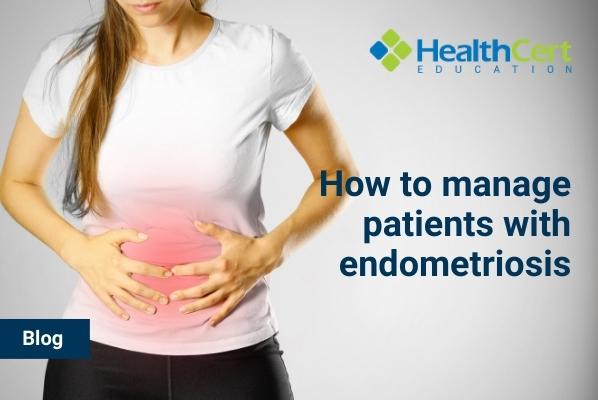How to identify and manage Bartholin’s cysts
Read more on how to identify and treat Bartholin’s cysts in your female patients of reproductive age, and learn when to refer women for specialist care.
.jpg)
HealthCert Education
Bartholin’s cysts occur in approximately two per cent of women. They are more common in women of reproductive age and may be associated with sexual activity, sexually transmitted infection (STI) or trauma to the area. Let's look at how this condition can be managed in the primary care setting.
Learn more about this topic in the HealthCert online Professional Diploma program in Women's Health.
The Bartholin’s glands are located lateral to the vaginal introitus and normally function to secrete a small amount of fluid via the Bartholin’s duct, which contributes to vulvovaginal lubrication. Blockage or occlusion of the distal Bartholin’s duct leads to fluid retention and cyst formation. Where a cyst has become infected, this may result in a Bartholin’s abscess.
Bartholin’s cysts typically present with unilateral vulval or vaginal swelling, and there may be a history of pain, dyspareunia, or pyrexia. Small cysts may be asymptomatic.
A Bartholin’s cyst is typically diagnosed via clinical examination, including digital vaginal examination. A cyst is usually readily visible and appears as a swelling at the inferior aspect of the labia majora, in the 5 or 7 o'clock position, which may be tender to palpation. Where infection is present, there may be associated inguinal lymphadenopathy, discharge, and systemic features such as pyrexia. It is essential to distinguish between a simple cyst and an abscess.
Management of Bartholin’s cyst depends on whether the patient is symptomatic, whether it has formed an abscess and the cyst/abscess size. A simple asymptomatic Bartholin’s cyst may not require any specific intervention. However, it is prudent to advise these patients to monitor for any changes in size or symptoms.
The patient can be advised to take warm salt water baths to encourage cyst drainage and maintain good perineal hygiene to prevent infection. The patient should be advised not to squeeze, lance, or otherwise interfere with the cyst and to seek medical advice if the cyst becomes painful, red, hot, increases in size or if any new symptoms arise.
For symptomatic cysts, surgical intervention may be considered. A word catheter is often the first-line surgical intervention, which involves making a small incision over the cyst under local anaesthetic and placing a balloon catheter into the cyst. This promotes drainage of the cyst and aids in preventing recurrence. This is a minor procedure that an appropriately trained clinician can carry out in an outpatient setting. For large or recurrent cysts, surgical marsupialisation may be considered. This involves involuting the outer surface of the cyst to allow continuous drainage and prevent cyst recurrence and is usually performed under general anaesthetic.
Antibiotics are indicated where infection or abscess is suspected, for example, if the cyst is accompanied by cellulitis, redness, pain, discharge, or systemic features.
A swab should be obtained for culture when an abscess ruptures, and appropriate analgesia should be advised. Broad-spectrum antibiotics can be commenced in the primary care setting. However, such patients should also be considered for referral secondary care for consideration of surgical management. Where Bartholin’s cyst is managed via conservative or surgical management and does not resolve, referral to secondary care is warranted.
Bartholin’s cyst represents a common and often painful condition affecting mostly women of reproductive age. It is essential for primary care doctors to be able to diagnose, manage, and appropriately refer patients to secondary care for this common condition.
Dr Samantha Miller, MBChB
Learn more about managing this condition in the HealthCert online Professional Diploma program in Women's Health.
Read another article like this one: Female pattern hair loss
Engaging with this blog can help meet your annual
|
|
|
1. Health Direct (2023). Bartholin’s cysts. https://www.healthdirect.gov.au/bartholins-cysts
2. BMJ Best Practice (2022). Bartholin’s Cyst. https://bestpractice.bmj.com/topics/en-gb/1060?locale=pt_BR
3. The Royal Women’s Hospital. Bartholin’s Cysts. https://www.thewomens.org.au/health-information/vulva-vagina/vulva-vagina-problems/abscesses
4. Family Planning Australia. Bartholin’s Cysts. https://reproductiveandsexualhealth.org.au/handbook/chapter-4/bartholins-cysts/
5. Queensland Health (2022). Vulva lesion/ lump/genital warts/ boil/ swelling/ abscess/ ulcer/ Bartholin’s cyst. https://www.health.qld.gov.au/cpc/gynaecology/vulval-lumps-diseases-of-the-vulva-vulva-lesi
6. NHS (2021). Bartholin’s Cyst. https://www.nhs.uk/conditions/bartholins-cyst/
7. National Institute for Clinical Excellent (NICE)(2009). Balloon catheter insertion for Bartholin's cyst or abscess. https://www.nice.org.uk/guidance/ipg323

 1800 867 1390
1800 867 1390
.jpg)
.jpg)




